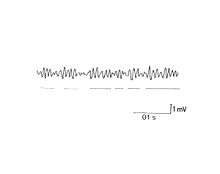Ocular tremor
Ocular microtremor (OMT) is a constant, physiological, high frequency (peak 80 Hz), low amplitude (estimated circa 150-2500 nm (1)) eye tremor.

It occurs in all normal people even when the eye is apparently still and is due to the constant activity of brainstem oculomotor units. In coma there is a loss of high frequency components of tremor and the extent of this reduction is related to the patient's prognosis (2). Ocular microtremor can potentially help in the difficult diagnosis of brainstem death, as well as monitoring patients while under anaesthesia (3). Abnormal OMT records are seen in neurological conditions such as Parkinson's disease and multiple sclerosis.[1] The frequency spectrum also changes with age.
The first description of what is now known as ocular microtremor was made in 1934 (4). More recent studies are less common for ocular microtremor than for other fixational eye movements. Some have suggested that the reason ocular microtremor studies are more rare may be because of the difficulty inherent in measuring microtremor.[2] It is contentious whether ocular microtremor assists vision. Visual processes deteriorate rapidly in the absence of retinal image motion, with Stabilized Images.[3]
Some have suggested that tremor may not be a distinct eye movement at all.[4]
See also
References
1. Sheahan, N. F., Coakley, D., et al. (1993). "Ocular microtremor measurement system: design and performance." Med Biol Eng Comput 31(3): 205-12.
2. Coakley, D. and J. G. Thomas (1977). "The ocular microtremor record and the prognosis of the unconscious patient." Lancet 1(8010): 512-5.
3. Bojanic, S., T. Simpson, et al. (2001). "Ocular microtremor: a tool for measuring depth of anaesthesia?" Br J Anaesth 86(4): 519-22.
4. Adler, F. H. M., Fliegelman, Maurice (AB) (1934). "Influence of Fixation on the Visual Acuity." Archives of Ophthalmology 12: 475-483.
- Bolger, C; Bojanic, S; Sheahan, N; Malone, J; Hutchinson, M; Coakley, D (2000). "Ocular microtremor (OMT): a new neurophysiological approach to multiple sclerosis". J Neurol Neurosurg Psychiatry. 68 (5): 639–42. doi:10.1136/jnnp.68.5.639.
- Alexander, Robert; Macknik, Stephen; Martinez-Conde, Susana (2018). "Microsaccade Characteristics in Neurological and Ophthalmic Disease". Frontiers in Neurology. 9 (144): 144. doi:10.3389/fneur.2018.00144. PMC 5859063. PMID 29593642.
- Rucci, Michele; Desbordes, Gaëlle (2003). "Contributions of fixational eye movements to the discrimination of briefly presented stimuli". Journal of Vision. 3 (11): 852–64. doi:10.1167/3.11.18. PMID 14765967.
- Stevenson, Scott B.; Roorda, Austin; Kumar, Girish (2010). "Eye tracking with the adaptive optics scanning laser ophthalmoscope". Proceedings of the 2010 Symposium on Eye-Tracking Research & Applications - ETRA '10. p. 195. doi:10.1145/1743666.1743714. ISBN 9781605589947.